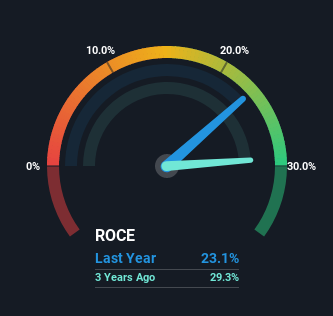- India
- /
- Consumer Durables
- /
- NSEI:DIXON
Dixon Technologies (India) (NSE:DIXON) Will Want To Turn Around Its Return Trends
If you're looking for a multi-bagger, there's a few things to keep an eye out for. Firstly, we'd want to identify a growing return on capital employed (ROCE) and then alongside that, an ever-increasing base of capital employed. Basically this means that a company has profitable initiatives that it can continue to reinvest in, which is a trait of a compounding machine. So when we looked at Dixon Technologies (India) (NSE:DIXON), they do have a high ROCE, but we weren't exactly elated from how returns are trending.
Return On Capital Employed (ROCE): What is it?
For those that aren't sure what ROCE is, it measures the amount of pre-tax profits a company can generate from the capital employed in its business. Analysts use this formula to calculate it for Dixon Technologies (India):
Return on Capital Employed = Earnings Before Interest and Tax (EBIT) ÷ (Total Assets - Current Liabilities)
0.23 = ₹2.7b ÷ (₹37b - ₹26b) (Based on the trailing twelve months to December 2021).
Therefore, Dixon Technologies (India) has an ROCE of 23%. In absolute terms that's a great return and it's even better than the Consumer Durables industry average of 13%.
Check out our latest analysis for Dixon Technologies (India)

In the above chart we have measured Dixon Technologies (India)'s prior ROCE against its prior performance, but the future is arguably more important. If you'd like, you can check out the forecasts from the analysts covering Dixon Technologies (India) here for free.
How Are Returns Trending?
In terms of Dixon Technologies (India)'s historical ROCE movements, the trend isn't fantastic. Historically returns on capital were even higher at 38%, but they have dropped over the last five years. However, given capital employed and revenue have both increased it appears that the business is currently pursuing growth, at the consequence of short term returns. If these investments prove successful, this can bode very well for long term stock performance.
On a separate but related note, it's important to know that Dixon Technologies (India) has a current liabilities to total assets ratio of 69%, which we'd consider pretty high. This can bring about some risks because the company is basically operating with a rather large reliance on its suppliers or other sorts of short-term creditors. While it's not necessarily a bad thing, it can be beneficial if this ratio is lower.
Our Take On Dixon Technologies (India)'s ROCE
In summary, despite lower returns in the short term, we're encouraged to see that Dixon Technologies (India) is reinvesting for growth and has higher sales as a result. And the stock has done incredibly well with a 791% return over the last three years, so long term investors are no doubt ecstatic with that result. So while the underlying trends could already be accounted for by investors, we still think this stock is worth looking into further.
Like most companies, Dixon Technologies (India) does come with some risks, and we've found 2 warning signs that you should be aware of.
High returns are a key ingredient to strong performance, so check out our free list ofstocks earning high returns on equity with solid balance sheets.
New: Manage All Your Stock Portfolios in One Place
We've created the ultimate portfolio companion for stock investors, and it's free.
• Connect an unlimited number of Portfolios and see your total in one currency
• Be alerted to new Warning Signs or Risks via email or mobile
• Track the Fair Value of your stocks
Have feedback on this article? Concerned about the content? Get in touch with us directly. Alternatively, email editorial-team (at) simplywallst.com.
This article by Simply Wall St is general in nature. We provide commentary based on historical data and analyst forecasts only using an unbiased methodology and our articles are not intended to be financial advice. It does not constitute a recommendation to buy or sell any stock, and does not take account of your objectives, or your financial situation. We aim to bring you long-term focused analysis driven by fundamental data. Note that our analysis may not factor in the latest price-sensitive company announcements or qualitative material. Simply Wall St has no position in any stocks mentioned.
About NSEI:DIXON
Dixon Technologies (India)
Manufactures and sells electronic goods in India and internationally.
Exceptional growth potential with solid track record.
Similar Companies
Market Insights
Community Narratives



